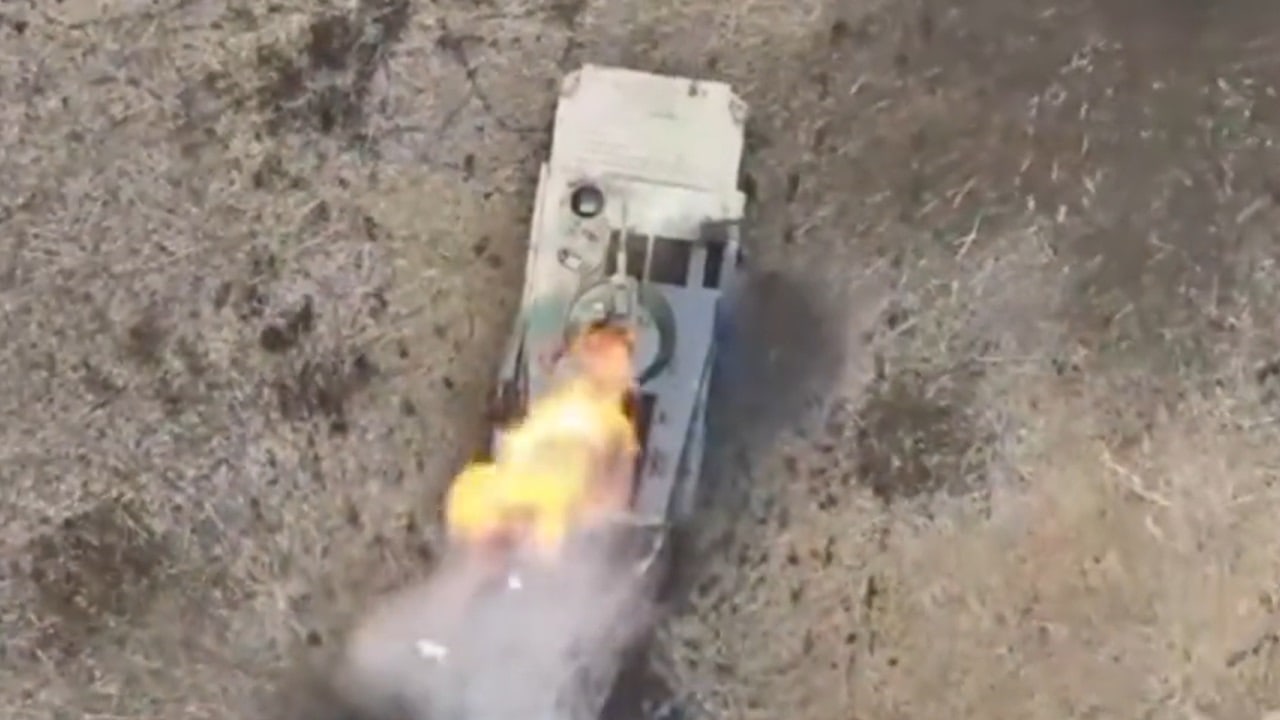There has been no shortage of videos shared on social media that show what ordnance dropped from a drone can do to a tank or other armored vehicle, but a new clip posted to Twitter on Monday captured the total obliteration of a Russian BMP-1.
The eight-second-long footage, shared by Ukraine Weapons Tracker (@UAWeapons), featured the exact moment a seemingly small piece of ordnance fell into the open hatch of the infantry fighting vehicle (IFV).
Normally in such clips, we’d expect to see a small flash, followed by a plume of smoke. Even that resulting explosion can be enough to seriously damage a vehicle, and in some cases set off ordnance inside the vehicle.
By contrast, this clip offered something that can only be described as a bit more “intense.”
That is because it wasn’t a mere fragmentation grenade that was deployed from an unmanned aerial vehicle (UAV) onto the IFV in the vicinity of the contested settlement of Avdiivka in the Donetsk Oblast. Rather it was an RGT-27S2 thermobaric grenade that was dropped with pinpoint precision into the vehicle’s hatch.
Immediately the BMP-1 explodes, hatches are blown off and the vehicle is engulfed in intense flames as the fuel and other lubricants burn off.
Aerosol Bomb
The Ukrainian RGT-27S2 (РГТ-27С2) is a high-explosive (HE), thermobaric, hand grenade that was originally developed for the destruction of enemy manpower in shelters of various types. It is a devastating weapon that uses oxygen from the surrounding air to generate a high-temperature explosion. During that explosion, the grenade creates a fire cloud of 13m³ for four seconds, where the temperature can reach 2500-3000 degrees Celsius (4500-5450 Fahrenheit). In addition to certainly killing anyone in a confined space, the heat can cause significant damage to a vehicle – and ignite any fuels or lubricants, and set off any ordnance.
Such weapons – known as aerosol or vacuum bombs – consist almost entirely of fuel rather than shrapnel. As these contain nearly 100 percent fuel, the results are significantly more energetic than conventional explosives of equal weight.
The weapons are not unlawful or prohibited by the Geneva Convention, but their use on civilian targets would violate the law of armed conflict (LOAC).
History in Warfare
The United States first employed thermobaric weapons in Vietnam, but those tended to be air-dropped. During the War in Afghanistan, the U.S. military employed such weapons against the cave complexes in which Al-Qaeda and Taliban fighters had taken refuge in the Gardez region.
#Ukraine: A Russian BMP-1 infantry fighting vehicle was destroyed by a RGT-27S2 thermobaric grenade dropped into an opened hatch from a Ukrainian drone in the vicinity of Avdiivka, #Donetsk Oblast. pic.twitter.com/ybxeeDaHVT
— ???????? Ukraine Weapons Tracker (@UAWeapons) April 17, 2023
More recently, both Russian and Ukrainian forces have employed thermobaric weapons, although Kyiv has reportedly largely used these against derelict Russian vehicles.
Images and videos circulated online in March of soldiers from the Ukrainian Army’s 59th Motorized Brigade dropping an RGT-27S2 hand grenade from a Mavic 3 drone into another Russian IFV. Though it is unclear which unit deployed the thermobaric weapon this week, it is possible it was the same operators.
The results were very much the same – one IFV won’t likely be worth recovering from the battlefield.
Author Experience and Expertise:
A Senior Editor for 19FortyFive, Peter Suciu is a Michigan-based writer. He has contributed to more than four dozen magazines, newspapers, and websites with over 3,200 published pieces over a twenty-year career in journalism. He regularly writes about military hardware, firearms history, cybersecurity, politics, and international affairs. Peter is also a Contributing Writer for Forbes and Clearance Jobs. You can follow him on Twitter: @PeterSuciu.

